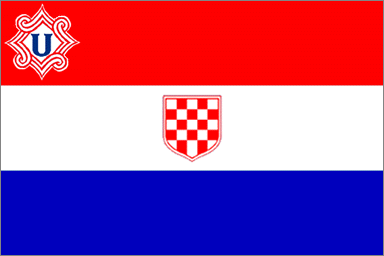Your donation will support the student journalists of Fossil Ridge High School. Your contribution will allow us to purchase equipment and cover our annual website hosting costs.
The background of the Yugoslav Crisis, 1914-1994
March 2, 2019
In 1914, at the start of World War I, The Kingdom of Yugoslavia was formed. Under the dictatorship of the Ustaše, a fascist Croatian party, Serbians, Croatians, and Slovenes lived under the rule of the Yugoslavian president. Then, in 1941, he was killed. The new president excluded fascists from all positions of power, creating tension. Upset with the exclusion of fascism, Nazi Germany and their Italian allies invaded Yugoslavia and returned power to Ustaše in most provinces. They immediately begin the massacre of ethnic Serbs.

The former Yugoslav Federation of 1991.
After Germany’s loss in World War II, Ustaše lost their backing from the Nazi party. Shortly after, the Yugoslavia monarchy was replaced with a Federal Republic and Josip Broz Tito was appointed president for life. With a Croatian father and a Serbian mother, Tito appealed to both sides of the conflict. President Tito ruled over all of Yugoslavia, a country composed of the following regions: Slovenia, Croatia, Bosnia and Herzegovina, Serbia, Montenegro, and Macedonia.
1980 marked the end of Tito’s leadership. His successor, being a weak leader, left the true power in the hands of the individual regions. The economy had just crashed as a result of the end of the Cold War, leading to ethnonationalism, a common sensation after any economic crisis. The people were putting their faith in the government and unknowingly creating a perfect storm.
In 1987, Kosovo, a province of Serbia, was in the thick of an ethnic conflict. Kosovar Serbs claimed Kosovar Albanians were taking their jobs and, still suffering from the effects of the economic crash, felt threatened and were looking for a scapegoat. As a result, they massacred the Albanians. Miloševič, the head of the Yugoslavian government, was sent in to decrease tension. An ethnic Serb himself, Miloševič’s presence only elevated conflict. Come 1989, Miloševič, now president of Serbia, replaced the presidents of Kosovo and Vojvodina, autonomous provinces within Serbia, as well as Montenegro, with his allies. A peaceful hunger strike of Albanian miners turned deadly, leading to Albanian whispers of hopes of independence.

The Ustaše flag of the 1940’s. This flag was emulated by Tudman in 1990.
In nearby Croatia, Franjo Tudman was selected in the 1990 election. A big nationalist, Tudman rejected communist ideals. He switched the Croatian flag to look similar to the Ustaše flag, upsetting ethnic Serbs living in Croatia. Though currently protected by the rules of the Yugoslavian government, the ethnic Serbs were aware of the impending secession of Croatia from Yugoslavia. In an attempt to prevent this, as it would have left the Serbs at the mercy of the Croatians who had a history of hate against them, the Serbs blockaded major roads in what came to be known as the Log Revolution. Because of their similar interests, the Yugoslav National Army (JNA) supported the ethnic Serbs. The Serbian revolutionaries renamed themselves the “Republic of Serbian Krajina.”
As the structure of Yugoslavia began to waver and many of the republics that were once a part of it recognized this, talk of independence from the larger republic became more commonplace. At the end of 1990, Slovenia became the first republic to hold a referendum on independence, which passed with almost 95% support. Yugoslavia declared a state of emergency, as they feared further declarations of independence—and with good reason. In May 1991, Croatia followed in declaring independence. The two republics fought Yugoslav soldiers for several months before signing a peace treaty that delayed their moving towards independence.
Meanwhile, throughout 1990 and 1991, the Republic of Serbian Krajina continued to fight for and increase their property throughout Croatia, even in non-Serbian-majority towns. The JNA allowed the Serbs to continue pushing through the republic, despite the fact that they were technically only in Croatia on a “peacekeeping” mission. Further adding to Yugoslavia’s downward spiral, Macedonia, in September 1991, also declared independence.
Miloševič rejected a peace deal that would have assuaged these conflicts because it would have broken up the rest of Yugoslavia, and the United Nations intervened in 1992, stilling the fighting between the Croats and Serbs.
However, Yugoslavia was by no means free of ethnic tension. Bosnia and Herzegovina were in a unique position, as the republic contained large populations of Catholic Croats, Orthodox Christian Serbs, and Muslim Bosniaks. The Bosnian Serbs declared themselves the Republika Srpska and pushed for Bosnia to remain in Yugoslavia, while the Bosniaks held their own independence referendum in 1992. This passed.

The Socialist Federal Republic of Yugoslavia flag.
In April of 1992, the Socialist Federal Republic of Yugoslavia released their communist ideals and became the Republic of Yugoslavia. However, they maintained their claims on their former republics. Simultaneously, the Republika Srpska began attacking Bosniak Muslims in and around the Bosnian capital, Sarajevo. To add a third level to the conflict, the Croats in Bosnia declared themselves the Republic of Herzeg-Bosnia and began trying to unify with Croatia.
In 1993, the UN placed several cities in Bosnia under their protection for the sake of their citizens. A proposed peace plan would have divided Bosnia into ethnic provinces, but the Republika Srpska refused to accept a course of action that would have lost them any of their land gains. Yugoslavia backed the Republika Srpska’s decision.
That was when the Republika Srpska began targeting civilians outside of Sarajevo, drawing the attention in early 1994 of the North Atlantic Treaty Organization. NATO demanded that Srpska remove their weapons from outside the city, which drew the attention of Russia, as they believed NATO was overstepping their role in global politics. Russia promised Radovan Karadžić, president of Srpska, that Russia would help them if NATO moved to remove their weapons from the hills, and Ratko Mladić, a commander in their army, attacked a UN safe area. The UN thus approved an airstrike against Srpska, and resultantly, Mladić took UN hostages.
